Introduction
Who would have thought that the escapades of a charismatic high school student in the '80s could offer valuable insights into the realm of Human Resources? Enter Ferris Bueller, the iconic protagonist of the movie "Ferris Bueller's Day Off." Beyond the laughs and lightheartedness, this classic film holds hidden gems that can enlighten us about employee engagement in the modern workplace. Join us on a journey through time as we uncover the HR lessons embedded in Ferris Bueller's adventures.
Lesson 1: The Art of Motivation
Ferris Bueller's unparalleled ability to motivate his friends into joining him for a day of adventure is a lesson in itself. Similarly, HR professionals must find creative ways to motivate employees. Recognizing their efforts, offering growth opportunities, and ensuring a positive work environment can inspire a sense of enthusiasm and commitment among the workforce.
Lesson 2: Flexibility Breeds Success
Ferris' ability to adapt to unexpected situations showcases the power of flexibility. In the workplace, acknowledging and accommodating employees' unique needs and preferences can lead to increased job satisfaction and productivity. Embracing flexible work arrangements and understanding individual work styles contribute to a happier and more engaged workforce.
Lesson 3: The Value of Work-Life Balance
While Ferris plays hooky, his day off underscores the importance of work-life balance. Encouraging employees to take breaks, vacations, and mental health days ensures they return to work recharged and motivated. An overworked and stressed workforce can lead to burnout, reduced productivity, and decreased engagement.
Lesson 4: Empowerment and Autonomy
Ferris' self-confidence and independence reflect the significance of empowering employees. Allowing them autonomy to make decisions, take ownership of projects, and contribute ideas fosters a sense of pride and ownership. Empowered employees are more likely to feel invested in their work and the company's success.
Lesson 5: Building Meaningful Relationships
Ferris' ability to connect with people from all walks of life speaks volumes about relationship-building. HR professionals should focus on creating a sense of community and belonging among employees. Encouraging open communication, team-building activities, and opportunities for collaboration can strengthen interpersonal connections.
Lesson 6: Celebrating Individuality
Ferris Bueller embraces his uniqueness and encourages his friends to do the same. In the workplace, acknowledging and celebrating employees' diverse talents, skills, and perspectives enhances inclusivity and boosts morale. Embracing diversity contributes to a richer work environment and fosters a sense of appreciation.
Lesson 7: Fun and Creativity Matter
From a parade dance to a memorable car chase, Ferris Bueller exemplifies the importance of injecting fun and creativity into life. Similarly, integrating fun activities and creative initiatives in the workplace can improve employee engagement. Whether it's themed events, friendly competitions, or innovative projects, a touch of creativity can make work more enjoyable and fulfilling.
Conclusion: Rewriting the Employee Engagement Playbook
As we revisit Ferris Bueller's timeless adventures, we unveil the hidden gems that mirror the principles of effective employee engagement. From motivation and flexibility to empowerment and celebration, the lessons embedded in '80s movies can guide HR professionals in creating workplaces where employees are not just present, but actively engaged and excited to contribute. So, take a cue from Ferris Bueller and rewrite the employee engagement playbook with a dash of '80s inspiration and a modern twist. After all, as Ferris famously said, "Life moves pretty fast. If you don't stop and look around once in a while, you could miss it."





